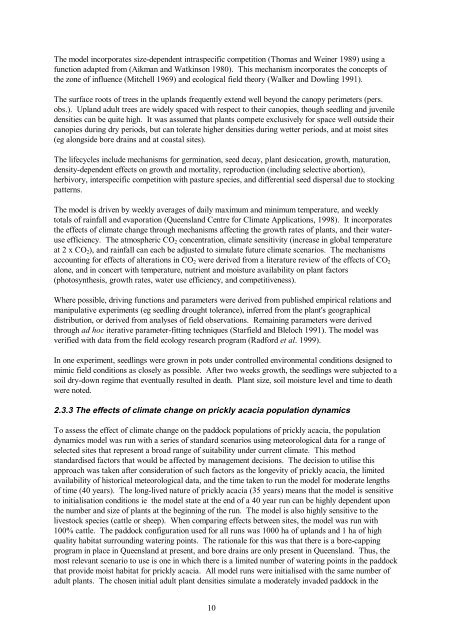EXOTIC WOODY WEEDS Use of simulation models to predict future ...
EXOTIC WOODY WEEDS Use of simulation models to predict future ...
EXOTIC WOODY WEEDS Use of simulation models to predict future ...
You also want an ePaper? Increase the reach of your titles
YUMPU automatically turns print PDFs into web optimized ePapers that Google loves.
The model incorporates size-dependent intraspecific competition (Thomas and Weiner 1989) using a<br />
function adapted from (Aikman and Watkinson 1980). This mechanism incorporates the concepts <strong>of</strong><br />
the zone <strong>of</strong> influence (Mitchell 1969) and ecological field theory (Walker and Dowling 1991).<br />
The surface roots <strong>of</strong> trees in the uplands frequently extend well beyond the canopy perimeters (pers.<br />
obs.). Upland adult trees are widely spaced with respect <strong>to</strong> their canopies, though seedling and juvenile<br />
densities can be quite high. It was assumed that plants compete exclusively for space well outside their<br />
canopies during dry periods, but can <strong>to</strong>lerate higher densities during wetter periods, and at moist sites<br />
(eg alongside bore drains and at coastal sites).<br />
The lifecycles include mechanisms for germination, seed decay, plant desiccation, growth, maturation,<br />
density-dependent effects on growth and mortality, reproduction (including selective abortion),<br />
herbivory, interspecific competition with pasture species, and differential seed dispersal due <strong>to</strong> s<strong>to</strong>cking<br />
patterns.<br />
The model is driven by weekly averages <strong>of</strong> daily maximum and minimum temperature, and weekly<br />
<strong>to</strong>tals <strong>of</strong> rainfall and evaporation (Queensland Centre for Climate Applications, 1998). It incorporates<br />
the effects <strong>of</strong> climate change through mechanisms affecting the growth rates <strong>of</strong> plants, and their wateruse<br />
efficiency. The atmospheric CO 2 concentration, climate sensitivity (increase in global temperature<br />
at 2 x CO 2 ), and rainfall can each be adjusted <strong>to</strong> simulate <strong>future</strong> climate scenarios. The mechanisms<br />
accounting for effects <strong>of</strong> alterations in CO 2 were derived from a literature review <strong>of</strong> the effects <strong>of</strong> CO 2<br />
alone, and in concert with temperature, nutrient and moisture availability on plant fac<strong>to</strong>rs<br />
(pho<strong>to</strong>synthesis, growth rates, water use efficiency, and competitiveness).<br />
Where possible, driving functions and parameters were derived from published empirical relations and<br />
manipulative experiments (eg seedling drought <strong>to</strong>lerance), inferred from the plant's geographical<br />
distribution, or derived from analyses <strong>of</strong> field observations. Remaining parameters were derived<br />
through ad hoc iterative parameter-fitting techniques (Starfield and Bleloch 1991). The model was<br />
verified with data from the field ecology research program (Radford et al. 1999).<br />
In one experiment, seedlings were grown in pots under controlled environmental conditions designed <strong>to</strong><br />
mimic field conditions as closely as possible. After two weeks growth, the seedlings were subjected <strong>to</strong> a<br />
soil dry-down regime that eventually resulted in death. Plant size, soil moisture level and time <strong>to</strong> death<br />
were noted.<br />
2.3.3 The effects <strong>of</strong> climate change on prickly acacia population dynamics<br />
To assess the effect <strong>of</strong> climate change on the paddock populations <strong>of</strong> prickly acacia, the population<br />
dynamics model was run with a series <strong>of</strong> standard scenarios using meteorological data for a range <strong>of</strong><br />
selected sites that represent a broad range <strong>of</strong> suitability under current climate. This method<br />
standardised fac<strong>to</strong>rs that would be affected by management decisions. The decision <strong>to</strong> utilise this<br />
approach was taken after consideration <strong>of</strong> such fac<strong>to</strong>rs as the longevity <strong>of</strong> prickly acacia, the limited<br />
availability <strong>of</strong> his<strong>to</strong>rical meteorological data, and the time taken <strong>to</strong> run the model for moderate lengths<br />
<strong>of</strong> time (40 years). The long-lived nature <strong>of</strong> prickly acacia (35 years) means that the model is sensitive<br />
<strong>to</strong> initialisation conditions ie the model state at the end <strong>of</strong> a 40 year run can be highly dependent upon<br />
the number and size <strong>of</strong> plants at the beginning <strong>of</strong> the run. The model is also highly sensitive <strong>to</strong> the<br />
lives<strong>to</strong>ck species (cattle or sheep). When comparing effects between sites, the model was run with<br />
100% cattle. The paddock configuration used for all runs was 1000 ha <strong>of</strong> uplands and 1 ha <strong>of</strong> high<br />
quality habitat surrounding watering points. The rationale for this was that there is a bore-capping<br />
program in place in Queensland at present, and bore drains are only present in Queensland. Thus, the<br />
most relevant scenario <strong>to</strong> use is one in which there is a limited number <strong>of</strong> watering points in the paddock<br />
that provide moist habitat for prickly acacia. All model runs were initialised with the same number <strong>of</strong><br />
adult plants. The chosen initial adult plant densities simulate a moderately invaded paddock in the<br />
10

















